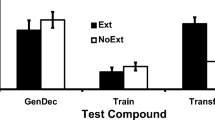Abstract
Two groups of rats were trained in a CER paradigm. The conditioned stimulus was a sound, the unconditioned stimulus was an electric shock. Group 1 received conventional CER training before the effects of different doses of diazepam were studied. For Group 2 the shock was always and exclusively given contingent on pretreatment with diazepam. After prolonged training the compound thus became a discriminative stimulus complex (DSC) and produced response suppression during the CS. Group 2 was also challenged with various doses of diazepam. The results showed that diazepam acquired diametrically different properties in the two groups. Group 1 exhibited disinhibitory effects and Group 2 suppressive effects, which may reflect anxiolytic and anxiogenic properties, respectively.
Similar content being viewed by others
References
Colpaert FC, Desmedt LKC, Janssen PAJ (1976a) Discriminative stimulus properties of benzodiazepines, barbiturates and pharmacologically related drugs: relation to some intrinsic and anticonvulsant effects. Eur J Pharmacol 37:113–123
Colpaert FC, Niemeegers CJE, Janssen PAJ (1976b) Theoretical and methodological considerations on drug discrimination learning. Psychopharmacologia 46:169–177
Dantzer R (1977) Behavioral effects of benzodiazepines. A review. Biobehav Rev 1:71–86
Estes WK, Skinner BF (1941) Some quantitative properties of anxiety. J Exp Psychol 29:390–400
Heistad GT, Torres AA (1959) A mechanism for the effect of a tranquilizing drug on learned emotional responses. Univ Minn Med Bull 30:518–527
Houser VP (1978) The effects of drugs on behavior controlled by aversive stimuli. In: Blackman DE, Sanger DJ (eds) Contemporary research in behavioral pharmacology. Plenum, New York, pp 69–157
Overton DA (1973) State-dependent learning produced by addicting drugs. In: Freeman AM, Fisher S (eds) Opiate addiction: Origins and treatment. Winston, Washington DC, pp 61–75
Author information
Authors and Affiliations
Rights and permissions
About this article
Cite this article
Haug, T., Götestam, K.G. Two opposite effects of diazepam on fear by differential training in the CER-paradigm. Psychopharmacology 75, 110–113 (1981). https://doi.org/10.1007/BF00432170
Received:
Accepted:
Issue Date:
DOI: https://doi.org/10.1007/BF00432170




